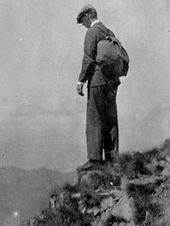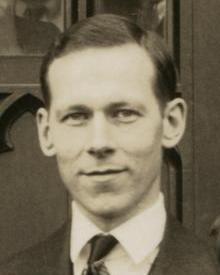Robert Mulliken
Robert Sanderson Mulliken (born June 7, 1896 in Newburyport , Massachusetts , † October 31, 1986 in Arlington ) was an American physicist and physical chemist .
In 1966 he received the Nobel Prize in Chemistry “for his fundamental work on chemical bonds and the electronic structure of molecules using the orbital method ”.
life and work
Mulliken was born in Newburyport , Massachusetts . His father, Samuel Parsons Mulliken, was a professor of organic chemistry at the Massachusetts Institute of Technology (MIT). As a child, Robert Mulliken learned the names and botanical classification of plants and generally had an excellent but selective memory. He learned the German language so well that he could skip the corresponding high school course, but he couldn't remember the name of his German teacher.
Mulliken helped his father create his four-volume work on the identification of organic molecules and became an early expert in the nomenclature of organic compounds.
At Newburyport High School he chose the science branch. He won a scholarship at MIT that his father had already received. In his first semesters he wrote his first scientific publication on the representation of organic chlorides. He also took some chemical engineering courses and worked as a student trainee at various chemical plants in Massachusetts and Maine. He received his BS in chemistry from MIT in 1917.
During the First World War he developed chemical weapons for the American Army at the American University in Washington, DC ; he suffered severe burns in the process.
After the war he worked on the influence of zinc oxide and carbon black on rubber , but began a Ph.D. in 1919. Program at the University of Chicago .

His doctoral thesis dealt with the separation of isotopes of mercury by evaporation ( The separation of isotopes. Theory of resolution of isotopic mixtures by diffusion and similar processes. Experimental separation of mercury by evaporation in a vacuum ). The doctorate took place in 1921 with William Draper Harkins . He became familiar with quantum theory through courses with Robert Millikan and through attending courses with Hermann Irving Schlesinger (1882–1960) in the chemistry of boron .
At Harvard University he learned spectrographic techniques from Frederick Albert Saunders and quantum theory from Edwin Kemble . At this time he met many of the later luminaries such as Robert Oppenheimer , John H. van Vleck and Harold C. Urey , as well as John C. Slater , who had worked with Niels Bohr .
In 1925 and 1927 he traveled to Europe to work with important scientists such as Erwin Schrödinger , Paul Dirac , Werner Heisenberg , Louis de Broglie , Max Born , Walther Bothe and Friedrich Hund . Mulliken was particularly influenced by Hund, who worked on the quantum mechanical interpretation of diatomic molecules. As a result, he developed his molecular orbital theory , also known as the Hund-Mulliken theory .
From 1926 to 1928 he taught physics at New York University . He then went to the University of Chicago as an associate professor , where he received a full professorship in 1931. During the Second World War, he headed the Information Office for the University's Plutonium Project from 1942 to 1945. In 1961 he became a Distinguished Professor of Physics and Chemistry. In 1985 he retired.
In 1936 he became a member of the National Academy of Sciences and in 1940 of the American Philosophical Society . In 1965 he was accepted into the American Academy of Arts and Sciences .
Fonts
- D. Ramsay, J. Hinze (Editor): Selected papers of Robert Mullikan. University of Chicago Press, 1975
- with Willis B. Person: Molecular complexes: A lecture and reprint volume , Wiley 1969
- with Walter C. Emler: Diatomic molecules, results of ab initio calculations , Academic Press 1977
- with Walter C. Emler: Polyatomic molecules, results of ab initio calculations , Academic Press 1981
- Life of a scientist: an autobiographical account of the development of molecular orbital theory , Springer 1989 (introduction by Friedrich Hund , editor Bernard Ransil)
- Molecular Scientists and Molecular Science- some reminiscences. In: Journal of Chemical Physics. Volume 43, 1965, S2-S11
Literature and film
- R. Stephen Berry: Biographical Memoirs of the National Academy of Sciences. Volume 78: Robert Sanderson Mulliken, 1896-1986. The National Academy Press, Washington, DC 2000, 146-165. PDF file, online .
- Per-Olov Löwdin, Bernard Pullman (Eds.): Molecular orbitals in chemistry, physics, and biology: a tribute to RS Mulliken, Academic Press 1964
- Film (English) : Friedrich Hund : Memories of Robert S. Mulliken (Reminiscences of Robert S. Mulliken) . Institute for Scientific Film (IWF) , Göttingen 1988, made available by the Technical Information Library (TIB) , doi: 10.3203 / IWF / G-232 .
Web links
- Literature by and about Robert Mulliken in the catalog of the German National Library
- Information from the Nobel Foundation on the 1966 award to Robert S. Mulliken
Individual evidence
- ^ Robert Sanderson Mulliken in Theoretical Chemistry Genealogy Project
- ↑ biographical data, publications and Academic pedigree of Robert Sanderson Mulliken at academictree.org, accessed on January 4 of 2019.
| personal data | |
|---|---|
| SURNAME | Mulliken, Robert |
| ALTERNATIVE NAMES | Mulliken, Robert Sanderson (full name) |
| BRIEF DESCRIPTION | American physicist and chemist |
| DATE OF BIRTH | June 7, 1896 |
| PLACE OF BIRTH | Newburyport |
| DATE OF DEATH | October 31, 1986 |
| Place of death | Arlington |

